Content marketing is one of the most effective levers B2B marketers have to drive business.
But it’s not merely putting “words on the digital page.” Your content has a big job: it must resonate with audiences, influence high engagement, create episodic experiences, and convert customers to benefit your business’s bottom line. To showcase the true value of your content, you need to pair a proven strategy with the right technology to deliver the right information at the right time to the right audiences.
According to an eCommerce Foundation study, 88 percent of your customers are researching your company through your online content before they ever reach out. Buyers are introduced to your company and to what you do through content, and ultimately, it informs their purchase decisions.
Make sure you understand how to serve them at each stage of their journey.
Below is what this sort of complex B2B buying journey can look like:

Introducing The Content Marketer’s Funnel—a comprehensive framework for content strategists, creators, and marketers. Whether you’re growing your SaaS customer base through product-led growth or ABM, your content strategy must scale with your ambitions. This ebook helps you identify which content formats and performance metrics move the needle at each funnel stage.

88% of your customers are researching your company through your online content before they ever reach out.
We’ll examine the flow and the metrics to help prove the value of your content in our all-digital climate. By definition, a marketing funnel is a modern application of the power of persuasion. Familiarity with your company, combined with your ability to create and publish valuable information, will be the recipe for success.
Much of what we’re discussing here can be made easier by using Parse.ly, part of WordPress VIP, which was created to overcome these challenges:
- Understanding your audience: Directly measuring audience engagement with content on your sites and apps.
- Informing your strategy: Leveraging 30+ content metrics to craft your content strategy to drive your business forward.
- Focusing on value creation: Using content conversions and attribution to understand the true impact of your content and fine-tune your strategy.
But whether you use Parse.ly or not, the recommendations below are easily applicable for any marketing program. With these pointers, you’ll be equipped to create a content funnel that systematically turns your audience into revenue-generating customers.
First, knowing your ideal customers
A key question to ask when setting up your content strategy is: What are you looking to achieve? Content strategies can be used to support a number of purposes, like increasing brand awareness or growing your customer base. Starting from the top and heading down the funnel, we’ll cover common content employed in each stage. The goal is to provide inspiration for your own content marketing funnel and arm you with metrics at each stage to ensure you’re confidently measuring and tracking success.
Before starting, the critical first step is to dig in and understand who your ideal customers are. The emphasis here is on “ideal.” Only then can you develop content that compels and converts those customers.
It also helps you understand who you are targeting and why. Once defined, the path to measuring the impact of the content becomes much clearer.
Our goal is for content strategists to use The Content Marketer’s Funnel to prove the value of content marketing to their business, stage by stage. The funnel has three main stages, broken down to fit within the parameters of your goals or key performance indicators (KPIs). Those stages help you ask the right questions and match metrics to those goals.
Let’s dive in.

Awareness
The top stage of the marketing funnel is awareness. The goal of this stage is to provide introductions to your company, brand, and products/services. The key to this stage is to cast a wider net for different audiences than your “core” and answer questions about topics you are an expert in.
We classify content that falls in the awareness stage in three different ways: paid, owned, and earned media. Paid media is any paid advertising initiative executed by your company; owned media is any type of content that your company creates, owns, and maintains; and earned media is any content about your company that is organically shared by people outside of it.
Let’s discuss in detail what those types of content look like in practice and how they fit into your overall strategy.
What content is in the Awareness stage?
As with all stages in the marketing funnel, content types will vary from company to company by industry, size, and the audience’s willingness to engage with the content. For a larger company, you may be able to invest more in top-of-funnel content through paid promotions on search engines or PR efforts. For a brand working within the IT space, you may need to publish more technical top-of-funnel assets to assert your credibility. And if you’re primarily marketing to a young adult audience, e.g., promoting an online therapy service, you may want to tailor your content to social media, chat, and video platforms.
Here are ideas of what might fall in your company’s awareness stage:
- Videos
- Paid promotion/PR
- Ads
- Sponsorships
- Events
- Partnerships
- Podcasts
- Social media posts
Understandably, it may be necessary for smaller companies to spend less or stay scrappy at the awareness stage. It’s commonplace to see heavier investment at the middle- and bottom-of-funnel stages.
However, the awareness stage is often overlooked. Content teams tend to focus on the later funnel stages. To ensure the rest of the full-funnel marketing works as it should, gradually winning over and qualifying new buyers along the way, the funnel must be fed from the top.
Make it a priority for a social media manager, events coordinator, or fellow content marketer to create content for the top-of-funnel in whatever lean way works for the bottom line–and keep SEO (and AI search optimization) top-of-mind.
Examples in the Awareness stage
For B2B marketers, publishing thought leadership content at the awareness stage helps establish credibility and trust, positioning a brand as an authority in its field. Credibility attracts potential customers, capturing them at the top of the funnel by providing valuable insights, trends, and resources (without a direct sales pitch).
For example, Scott Brinker, HubSpot’s VP of Platform Ecosystem, writes the wildly popular ChiefMartec blog, “breaking down complex technological trends into digestible insights, often sharing deep-dives and expert interviews to keep his audience informed and ahead of the curve,” says Brand Theory’s Carter Edsall. A classic, traffic-driving thought leadership example is Brinker’s annual overview of the MarTech landscape, a must-read for marketers in the B2B space.

Any marketing funnel stage can look vastly different by company or business, industry, or goals. We’ll share two different examples for each stage to showcase what these can look like for two very different companies. The aim is to get you thinking about what the application of this stage could mean for your audience, content, and marketing goals.
For the work management platform Fibery, which connects a product team’s tech stack to their company’s organizational goals, top-of-funnel content must educate readers about what the product does and why they need it. In the example below, Fibery adjusted the messaging on their homepage to better communicate the power and value of their tools.
Remember, the content on your homepage is typically the first thing your target audience reads when researching your brand. Hone in on the messaging that resonates most with your audience to optimize top-of-funnel conversion by testing headlines, website copy, and CTAs.


What metrics are most important at the Awareness stage?
Content should be closely aligned with the KPIs of each stage of the funnel. In the awareness stage, these will be high-level metrics like traffic to your website, specific pageviews, social shares, or other tallies of top-of-funnel activities, like event attendees or leads generated from sponsorships or collaborations.
Social media is a prime example of top-of-funnel content. The target metrics have traditionally been views, “impressions” in social media terms, and click-throughs to determine its effectiveness versus other ads. Ad platforms for social media provide a dashboard to follow these metrics, but tracking interest or true engagement on non-ad social requires a bit more digging or simply using more content-centric analytics solutions.
You want to be looking at deeper social metrics like social referrals, social interactions, and social referrals per interaction. Parse.ly has direct integrations with many social media platforms, so we’re able to surface these more meaningful metrics. We even show you the specific accounts that share or refer to your company’s posts.
In Fibery’s case, to see which homepage messaging is creating the most top-level awareness for their brand, they can A/B test and measure which version receives more traffic and for how long (engaged time), and which headlines and CTAs perform better.

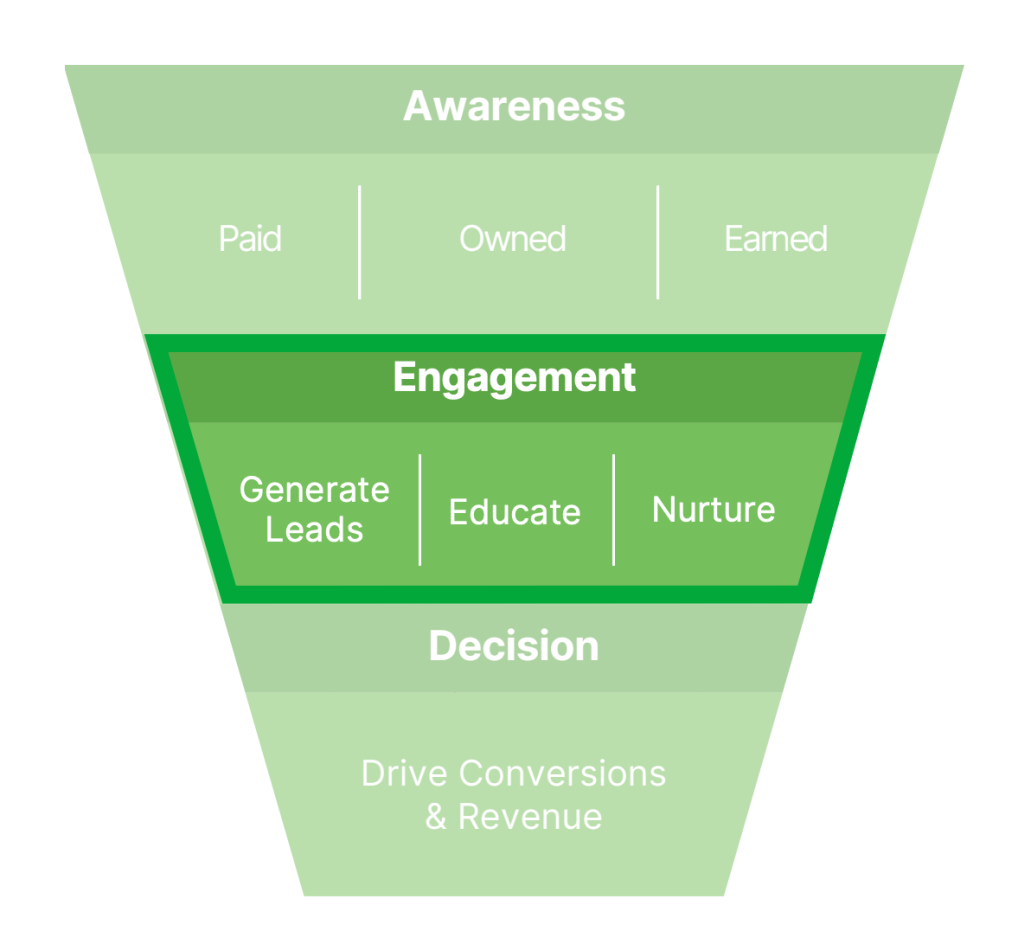
Engagement
At this stage, the goal is to foster further engagement, often in exchange for contact information to converts a user to a lead. It’s about driving your audience from passively reading a piece of content, for example, to actively engaging by clicking, downloading, or registering for a webinar.
In the age of digital marketing, as a rule of thumb, this action is frequently a click. What can motivate a prospect traveling down the funnel to raise their hand and say, “Hey, I’d love to get some more information”?
The key at this stage is educating the audience, proving the credibility or depth of your expertise, and ultimately, solidifying those previously passive audience members as viable, interested leads who want to learn more about what you are selling.
What content is in the Engagement stage?
Think of the engagement stage as deeper conversations about industry-specific topics that aren’t centered around your products or services. This could be a webinar, an in-depth ebook, a newsletter, or whatever compels people to trust your company, come to you for authority, and ultimately, be willing to give you their contact info.
A larger company might host a weekly workshop or webinar with a panel of subject-matter experts in their industry.
A specialized company, like a marketing agency, might create an ebook around marketing best practices.
A media publication might launch a weekly newsletter to notify their audience of recently published content.
Here are more ideas worthy of your company’s engagement stage:
- Nurture campaigns
- Online courses
- White papers
- Data studies
- Case studies
The goal of the engagement stage is to capitalize on awareness by delivering more educational information and opportunities to engage with your company. Ideally, your audience will give you their contact information in exchange, allowing you to nurture them further.
Examples in the Engagement stage
In-depth information and product-specific solutions foster additional trust and credibility with audiences in the engagement stage, encouraging prospects to interact more deeply with your brand and move closer to conversion.
To drive demo sign-ups on their site, Cognism, a sales intelligence platform competing against giant ZoomInfo, freely showcases nine email sequences for sales representatives to increase conversions. Of particular interest is their SaaS free trial nurture sequence: three succinct emails, touching on onboarding, feature highlights, and trial results.
Their goal: convince a free trial user to upgrade to a paid plan. It’s a clever play. By giving away their nurturing expertise as templates, Cognism influences demo sign-ups of their own service.
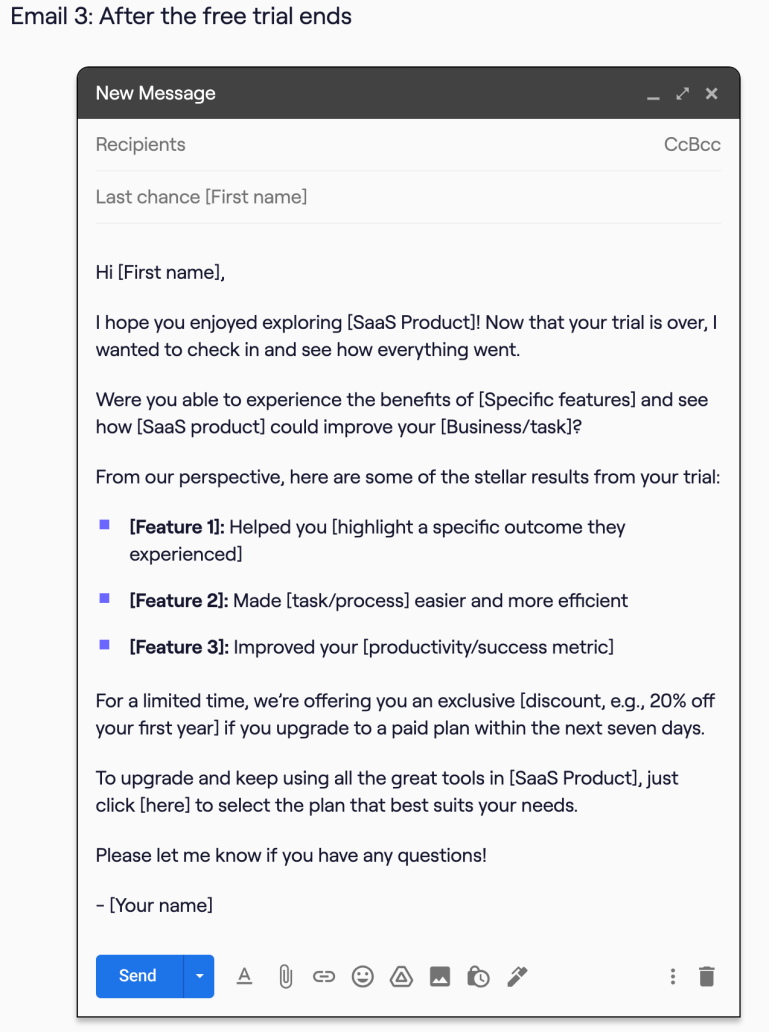
Focusing on B2B marketers, WordPress VIP and Parse.ly regularly publish educational content (often requiring a form fill to collect audience contact information).
Prime examples include state-of-the-industry reports like our Content Matters series and The State of Product at Publishers. Evergreen how-to guides that help B2B marketers do their jobs better include our Measuring Content Marketing ROI: How to Make the Case for a Bigger Budget and How to Write a Content Marketing Budget.


Chorus.ai (now part of ZoomInfo) is a sales conversation intelligence platform that helps customers drive team performance, build stronger relationships, and acquire unbiased market intelligence. To speak directly to their sales audience and capitalize on high-level awareness, they publish resources on sales methodologies and how to effectively close sales, along with comprehensive competitive reports on conversation intelligence.
These resources always require a click-through to read or download, so that Chorus.ai collects user information and generates leads for its sales team.
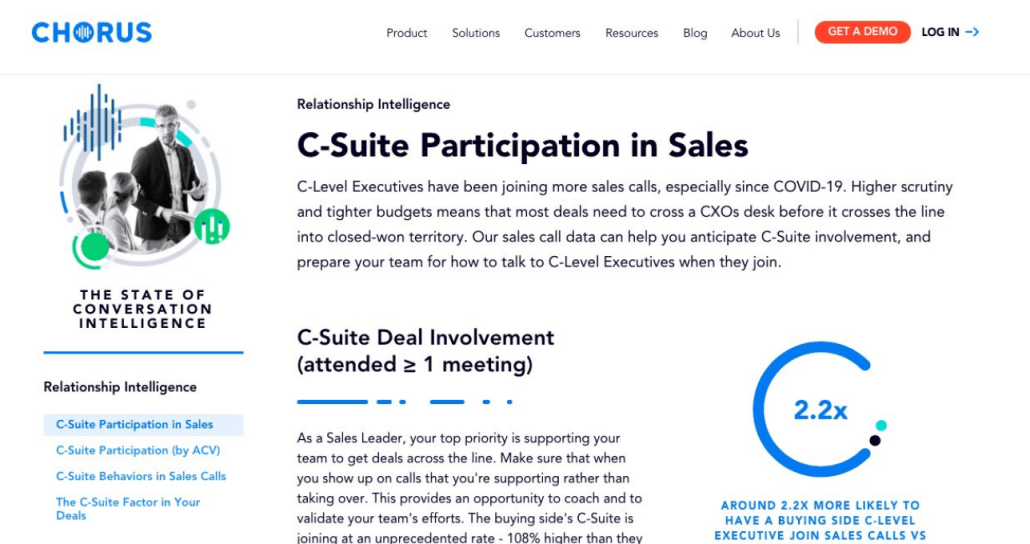
What metrics are important at the Engagement stage?
Monitoring how effectively your engagement stage content is fostering trust for your business derives from engaged time. This helps you understand which content is holding your audience’s attention and providing real value.
Beyond the surface-level engagement metrics of timestamps, time-on-page, or bounce rate, Parse.ly’s engaged time metric is useful for understanding how valuable your content is to your audience at more granular points along their journey through your funnel. This metric is especially helpful for companies with longer sales cycles, either because they have more expensive products/services or a sales process that involves many decision makers.
Engagement is a key step in qualifying the right leads as they move toward the decision-ready stage. Of course, what drives engagement will vary from company to company. It could be content downloads to show interest in a closer-to-decision topic, or email or newsletter sign-ups to continue getting product updates. Tracking content conversions will provide valuable insight into what’s working.
Remember, downloading a piece of content, for example, indicates everything from simple interest to outright trust in your research or industry authority on a subject. So the number of downloads represents engagement. If a particular email drip sequence ends with a click-to-download option, you can also measure email opens or click rates along the way.
The questions you should be asking at the engagement stage are: “Did your audience act in a way that indicates they’re ready and willing to learn more about your products or services?” and “‘Are they ready to be sold based on what you know from their more meaningful, deeper interactions with your brand or content?”
For any company, the key to this mid-funnel stage is loading up the top with a broad audience. Qualification processes are necessary as your audience progresses down the funnel, but the more awareness you start with at the top, the better.
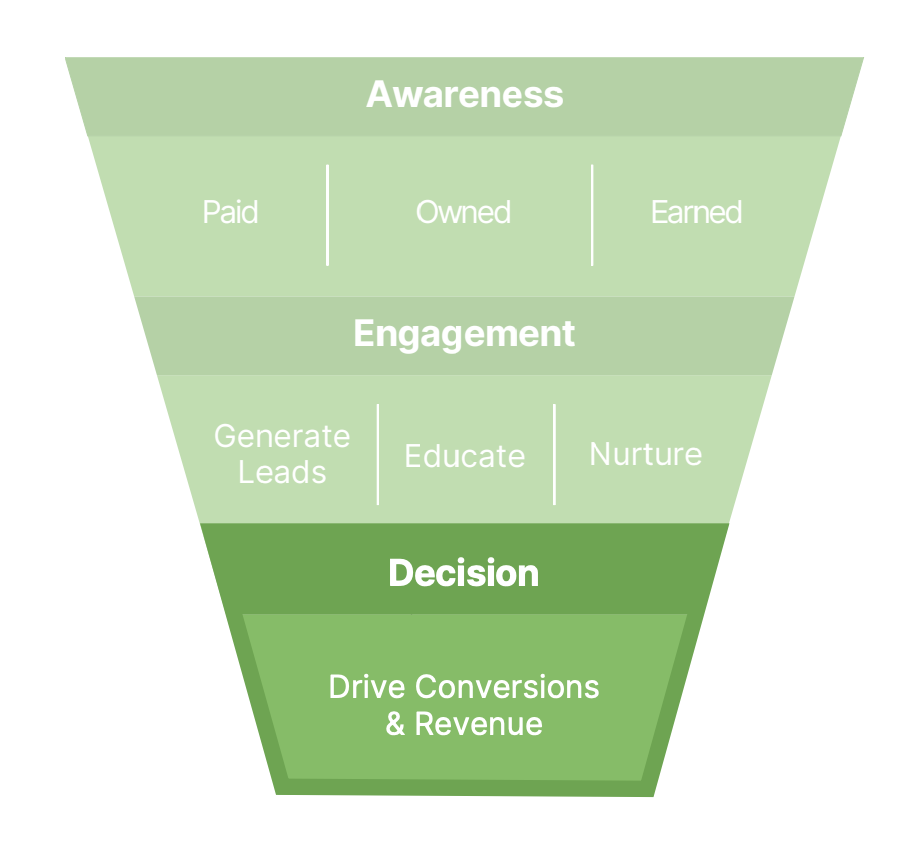
Decision
The decision-making stage of the funnel is just what it sounds like: getting your audience to make a decision that makes you money. The actions at this stage are directly tied to revenue—swiping a credit card or signing a contract, or the final steps that indicate buying readiness—signing up for a “hard sell” product demo with a salesperson, or signing up for a limited free trial by entering payment information.
The commonality of these actions is that they represent other ways of saying, “I want to buy what you’re selling!” or “I’ve decided to give your company a chance to solve my problem.” You can think of this as what many marketers term opportunity creation.
What content is in the Decision stage?
The following are some ideas of what could fall in your decision stage, but they are certainly not limited to this list:
- Add to cart
- Case studies
- Product or service reviews/testimonials
- Subscription signups
- Onboarding, knowledge guides, how-to videos, user forums/communities
Examples in the Decision stage
In the decision stage of the marketing funnel, case studies, explainer videos, and “how-to” onboarding guides help reinforce prospects’ decisions to sign up for a product or subscription service, facilitating a smoother transition to becoming customers.
Broadcast2World’s collection of the best explainer videos provides a wide range of compelling examples that mix animation, infographics, data, and emotional storytelling—“showing not telling” prospective customers how products and services work. It’s a growing trend, as HubSpot reports that more than nine in 10 businesses are incorporating video into their marketing.

CallRail is a call-tracking marketing platform that helps businesses track prospect and customer activities (calls, texts, form submissions). Its software has a free 14-day trial, which is usually the final step in a buyer’s journey before purchase.

Case studies that seal the decision-stage deal don’t come much bigger or more stellar than B2B agency Lone Rock Point highlighting their work to rebuild NASA’s flagship website on WordPress. Tying into NASA’s mission to “inspire humanity through a unified, world-class NASA web experience,” Lone Rock Point not only sells their own technical expertise via a deep breakdown of the project and its benefits, but also the value of an organization standardizing on the WordPress CMS platform. In effect, it’s a two-for-one at the decision stage.

What metrics are most important at the Decision stage?
Again, at the decision stage, it boils down to revenue—the KPI that executives care about. It’s the bottom line, closed-won revenue, or the summation of revenue-driving actions, such as free trials or subscription sign-ups, from your audience. Parse.ly’s content conversions tracking feature allows you to easily prove what content is driving those results, tying content performance directly to revenue.
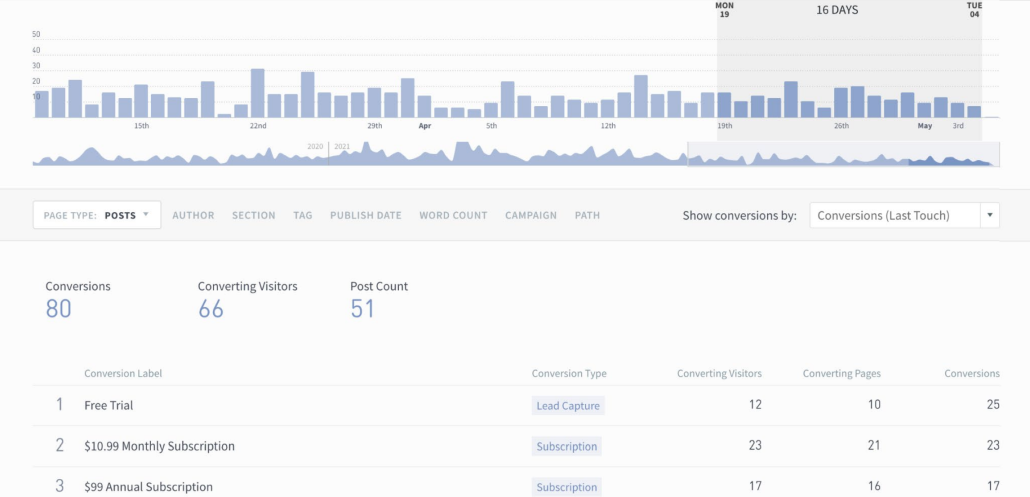
Monitoring your bottom-of-funnel performance is undoubtedly important to drive business, but it’s only one piece of the puzzle. People at your company who don’t work in content can become hyper-focused and myopic on the bottom of the funnel, sometimes to the detriment of the business, so remember to use this ebook to help you prove the value of your content along the way.
Remember, bottom-of-funnel content loses its punch when it’s not balanced with educational, higher-funnel materials. Simply saying “buy, buy, buy” on your website will have your leads saying “bye, bye, bye.”
Takeaway for B2B marketers: Optimize your company’s marketing funnel with Parse.ly insights
Optimize your company’s marketing funnel with Parse.ly insights. To understand the effectiveness of your content marketing funnel, track relevant KPIs and metrics at each stage. As with any marketing initiative, content strategy requires advanced thought and planning to achieve the best results.
By following the steps we’ve outlined in this ebook, you’ll be on your way to a documented, scalable strategy that targets the right audience and achieves bottom-line results. Parse.ly—part of WordPress VIP— is agile enough to cater to each business’s measure of content success. Interested in seeing how Parse.ly can augment your data-driven content marketing? Get a demo from our team of data experts.
